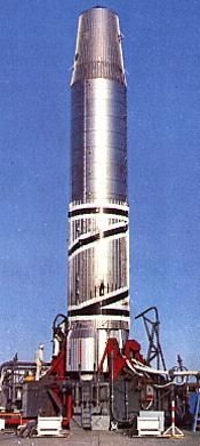Blue Streak: Missile in search of a missionby Trevor Williams
|
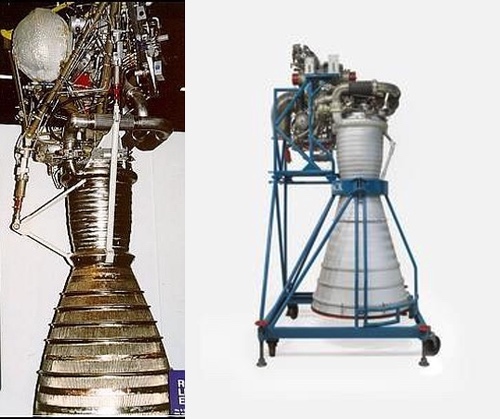 Rocketdyne S-3 engine (left) and “anglicized” Rolls-Royce RZ-2 version (right). (credit: USAF and Imperial War Museum, resp.) |
The United States was also prepared to share information in the field of rocket engines, so Rolls-Royce obtained a Rocketdyne S-3 engine: this was based on the booster engines of the Atlas missile and was used in the Jupiter, Juno II, and Thor rockets. Rolls-Royce produced three virtual copies of this as the RZ-1, and then developed an “anglicized” RZ-2 version optimized for Blue Streak [3, pp. 49-50]. Given that the S-3 was a kerosene/oxygen engine, this same propellant combination was necessarily also used for Blue Streak.
| Each underground launcher would require as much concrete as about 10-20 miles of divided highway in the motorway system that was then under construction in Britain. It was not clear that these demands could be satisfied simultaneously. |
The design of the Blue Streak IRBM was completed by 1957 but it was cancelled as a military project in 1960, before any test flights had occurred. Cancellation occurred largely due to cost increases, which in turn were linked to efforts to ensure that the missile was not excessively vulnerable in time of war. Blue Streak was never intended for use as a first-strike weapon, so its deterrence capability required that it be able to provide retaliation in the event of a nuclear strike on the United Kingdom. It therefore had to be able to survive such a strike in launchable condition. This was to be achieved by launching the missiles from “underground launchers” (the term “silos” was not yet in use) using the “fire in the hole” technique. It was estimated that about 60 such launchers would be required, spread out sufficiently that a single incoming missile could not destroy more than one of them. Identifying acceptable locations for these sites was challenging given the many constraints that had to be satisfied, particularly considering the small size of Britain, where no point is more than 130 kilometers from the sea. For instance, launchers had to be kept isolated from centers of population and from their evacuation routes, and they had to avoid locations with high water tables. One promising site also had to be ruled out because it was too close to the royal residence of Sandringham House [3, p. 95].
Since the proximity of Britain to the Soviet Union only allowed at most 15 minutes warning of an incoming missile, the launch system was designed to allow rapid response. For various reasons, this led to the launchers becoming massive structures, predominantly made of concrete together with a steel Faraday cage to protect against electromagnetic pulses. For instance, since Blue Streak did not use storable propellants, the missiles could be held loaded with kerosene, but the launch system had to be able to load the liquid oxygen shortly before launch: in the interests of speed, this was performed using a system driven by six tons of compressed nitrogen. Also, the 750-ton steel door that protected the launcher was designed to take only 17 seconds to slide open. In addition, living quarters had to be provided for the launch crew for a total of four days, covering three days before an attack and one day after, in case an earlier response were not feasible. The end result was that each underground launcher, which was U-shaped with one arm for the missile and one for its exhaust gases, would require as much concrete as about 10-20 miles of divided highway [3, p. 101] in the motorway system that was then under construction in Britain. It was not clear that these demands could be satisfied simultaneously.
Design of the Blue Streak underground launchers predated those of the silos for the Atlas and Titan missiles, and progress was followed with interest by the USAF. Comparing a Titan II silo with the Blue Streak design, the Titan had the advantage of using storable propellants; also, the geographical constraints were not so severe. Design and construction of the Blue Streak underground launchers turned out to be so challenging [3, pp. 80-103][5, pp. 125-139] that all that was actually built was a one-sixth scale model at the Rocket Propulsion Establishment at Westcott, as well as the start of some excavations at Spadeadam and Woomera.
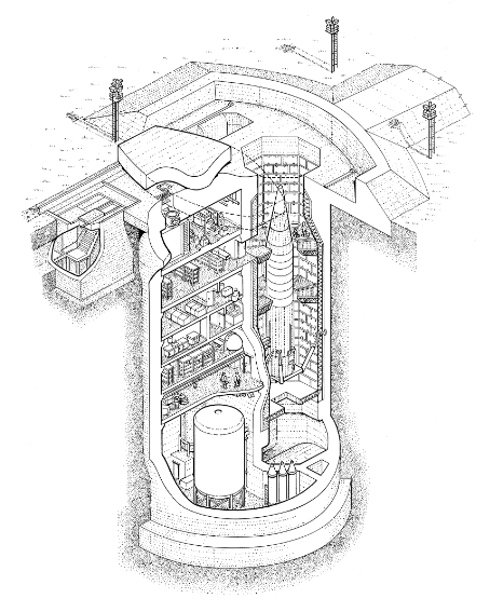 Blue Streak underground launcher. (credit: Hill, A Vertical Empire) |
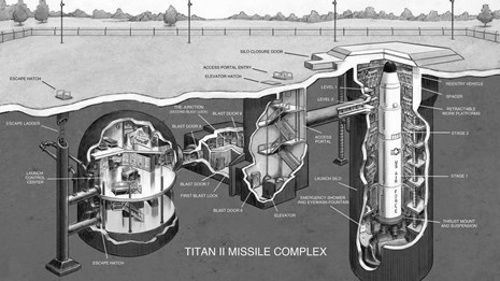 Titan II launch silo. (credit: US National Park Service) |
Unfortunately, without underground launchers, Blue Streak would have been unacceptably vulnerable; with them, it became prohibitively expensive. These considerations were key to the decision in April 1960 to cancel Blue Streak in its IRBM role. It was to be replaced by the US Douglas GAM-87 Skybolt air-launched ballistic missile carried by Vulcan bombers, but Skybolt was itself cancelled in late 1962, without consultation, by the US government. The end result was that the British independent nuclear deterrent was ultimately (from 1968) provided by US-developed Polaris missiles carried on British submarines.
However, Blue Streak development continued, with it now under consideration as the first stage for some as-yet unidentified civilian launch vehicle. This was presumably an effort by the government to gain some benefit from the roughly £70 million [6, p. 121] spent on it up to that point. The various proposed launch vehicles will now be discussed.
Studies of proposed Black Prince launch vehicle, 1957–1963
One candidate all-British launcher involved using Blue Streak as the first stage, a modified version of the small Black Knight research rocket that had been developed in support of the IRBM project as the second stage, plus an additional third stage. This combination, referred to as Black Prince (or officially the Blue Streak Satellite Launch Vehicle, BSSLV), was first proposed by Desmond King-Hele of the Royal Aircraft Establishment (RAE) in Farnborough in a report dated May 1957 that described its predicted performance [5, p. 182]. Geoffrey Pardoe, the Blue Streak project manager at de Havilland Propellers, presented various similar satellite launch vehicle designs starting in 1959 [7]. One of these repackaged the Black Knight-derived upper stage into a near-sphere matching the 10-foot Blue Streak diameter [5, pp. 183-184]. Unfortunately, the British government was unwilling to spend the additional £60 to 70 million [6, p. 121] that would have been required for development of the BSSLV.
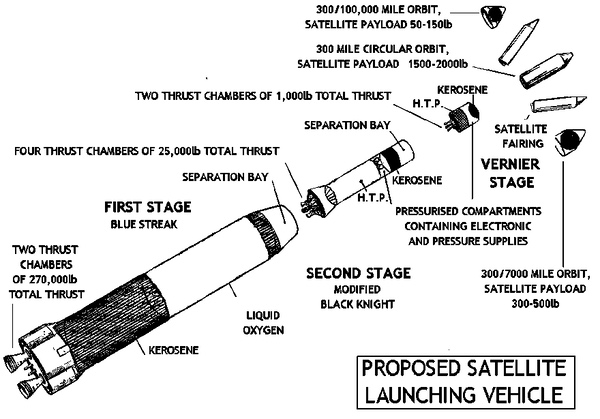 One design of proposed Black Prince satellite launch vehicle. (credit: Kaye Dee) |
Incidentally, King-Hele’s primary work at RAE was not actually on launch vehicle design, but rather on advanced orbital dynamics. In particular, he was a pioneer in the field of satellite geodesy, where irregularities in the gravitational field of the Earth can be quantified by observing the perturbations that they cause to the orbits of satellites. The most significant of these irregularities is the flattening of the poles caused by the rotation of the Earth. Next in importance is the “pear-shape” harmonic of the planet: King-Hele was able to refine the estimate for this, finding that the north and south polar radii differ by about 40 meters. In 1966 he was made a Fellow of the Royal Society (FRS), the highest fellowship available to British scientists, the first to be so honored for space science. His published works included orbital textbooks, biographies of Erasmus Darwin and Percy Bysshe Shelley, and books for the general public on observing satellites (see [8].) His writing style could never be described as dry. For instance, in [8, p. 167] he wrote:
…it is a nice coincidence that exactly 50 years after Peary discovered the North Pole, the North Pole was discovered to be peary.
 Desmond King-Hele of RAE. (credit: Vandyck Studios) |
King-Hele and Pardoe later became celebrated among space enthusiasts in Britain: in the case of Pardoe, this stemmed from his role as a regular member of the BBC TV coverage team for the Apollo missions. In King-Hele’s case, it came from his accurate prediction of the year of reentry of Skylab, 1979, soon after the space station was launched in 1973. By contrast, the “official” reentry predictions often stretched into the early 1980s, leading to plans to attempt a reboost using one of the early Space Shuttle missions. This effort became moot partly as a result of Shuttle development delays and partly due to the earlier decay of Skylab’s orbit, leading to the spacecraft reentering over Australia.
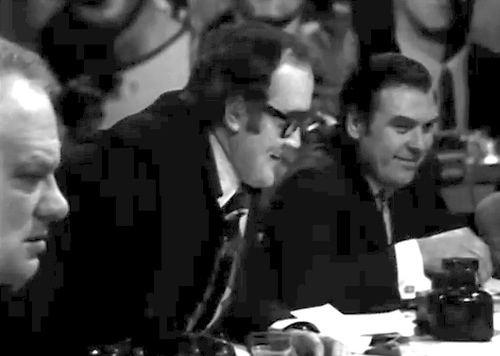 BBC TV Apollo 13 coverage team shortly after the spacecraft successfully emerged from reentry blackout: Patrick Moore (left), James Burke (center), Geoffrey Pardoe (right). (credit: Antonis Skar) |
Blue Streak and Europa, 1962–1972
Given that development of an all-British launch vehicle based on Blue Streak was not financially viable, attempts were made to identify potential international partners. Development of a Commonwealth launcher was considered, but the key countries of Canada and Australia were not interested. European cooperation was the next logical step, and discussions began in 1960. In the early stages, European interest was mainly limited to France, so development was considered of a launch vehicle with Blue Streak first stage and French second stage. In some respects, this amounted to the Black Prince with a French second stage replacing the modified Black Knight.
| Blue Streak development continued, with it now under consideration as the first stage for some as-yet unidentified civilian launch vehicle. This was presumably an effort by the government to gain some benefit from the roughly £70 million spent on it up to that point. |
Eventually though, the European launcher design coalesced into Europa, the development of which started in 1962 under the European Launcher Development Organization (ELDO). Funding was mostly from Britain, with other significant but smaller contributions from France and Germany, and still less from Italy, Belgium, and the Netherlands. The design of the vehicle reflected this funding breakdown: the first stage was Blue Streak, the second stage the French Coralie, and the third the German Astris (both using bipropellant hydrazine engines), with Italy providing the fairing. A small solid fourth stage, the French Diamant BP4, was later added to Europa to form the Europa 2. In case the development of Europa hit snags, RAE and Saunders-Roe considered a contingency plan whereby the upper stages could be replaced by Black Arrow mounted on Blue Streak: to allow for this, the Black Arrow base diameter was specified to be two meters, identical to that of the Coralie stage. In the Black Arrow design, all other dimensions were of course given in imperial units [5, pp. 195-196].
 Blue Streak/Black Arrow stack (left) and Europa (right). (credit: Hill, A Vertical Empire) |
Blue Streak static testing in support of the Europa test flights took place at Spadeadam in the north of England, after which the stage was shipped to Australia for launch from the Woomera rocket range. The first three test launches were simply of the Blue Streak IRBM alone. The first of these, known as Europa flight F1, took place on June 5, 1964. The vehicle experienced instability during the final stages of powered flight, leading to engine cutoff six seconds prematurely, but was still considered a success. Subsequent analysis revealed that the instability was caused by the chosen autopilot gains: these led to excessive lateral oscillations, in turn leading to propellant starvation to the engines [9]. The autopilot gains were adjusted prior to the following two tests, F2 on October 20, 1964, and F3 on March 22, 1965, and both were complete successes.
The next two flights, F4 on May 24, 1966, and F5 on November 15, 1966, still had only active Blue Streaks, but now topped by dummy second and third stages and fairing. Both of these launches were also successful.
The next two tests, F6/1 on August 5, 1967, and a repeat attempt, F6/2 on December 5, 1967, were equipped with active first and second stages and a third stage mockup. Both experienced failures of the French Coralie second stage.
Flights F7 on November 30, 1968, and F8 on July 3, 1969, both had a fully active stack. Both of these experienced failures, suspected of identical causes, of the German Astris third stage. In the subsequent flight F9 on June 12, 1970, faulty pressurization of the Astris propellant tanks led to reduced, and then intermittent, thrusting, and finally to premature shutdown. In addition, the fairing failed to separate: subsequent analysis revealed that the vehicle could have reached orbit in the face of either of these failures, but the combination of reduced thrust and increased mass made this impossible [5, pp. 235-236]. (Coincidentally the Black Arrow R2 launch, which took place about three months after Europa F9 and also at Woomera, experienced a similar combined failure of upper stage pressurization and fairing separation. [5, p. 309].)
Europa flight F10 was cancelled for budgetary reasons, so the next, and indeed final, Europa launch was F11, which took place on November 5, 1971. This was in fact the first test of the four-stage Europa 2, and took place from Kourou in French Guiana, which was recognized as far better suited to future launches into geostationary orbit than was Woomera. Unfortunately, this launch failed due to guidance system problems: arcing [5, p. 236] between the payload fairing and the third stage, where the guidance system was housed, caused the vehicle to pitch over excessively, leading to structural failure from aerodynamic forces between the first and second stage [10].
| Consequently, by pulling out when it did, a British Treasury goal that space should “pay its own way” was totally missed out on, perhaps due to the Treasury inability to foresee any economic payback from satellites. |
After this, enthusiasm for Europa and for ELDO, the management structure of which was recognized to be part of the problem, had worn thin. ELDO ceased to exist, merging into the new European Space Agency in 1975. In the process, Britain went from being the most active country in European launcher development to basically pulling out of such efforts entirely. The underlying long-standing government position can be seen from a memo written by F.A. Barratt of the UK Treasury on October 19, 1964, to brief the incoming Chancellor of the Exchequer after the 1964 election [5, p. 360]:
We should therefore contract out of all these activities; if Europeans wished to go ahead wasting money on space, that is their affair.
Britain was even prematurely reported in 1966 [11] as having already decided to leave ELDO. This news item observed presciently that:
The British decision to quit ELDO… seems to have pushed France into a leading position in Western Europe.
When Britain actually did pull out of European launcher development after flight F11, it was an unfortunate time to lose nerve: after funding 11 Europa launches with little to show for them besides an impressive unbroken series of successful Blue Streak tests, Britain ended up not participating in the very successful Ariane program, which was led by France. Between 1979 and 2003, the Ariane 1 through 4 family performed 144 launches in total, mainly of geosynchronous spacecraft. By 1986, nearly 60% of all commercial launch services were provided by Ariane. The subsequent Ariane 5 (not a direct development of the Ariane 1-4 family) performed 117 additional launches, bringing the total to 261.
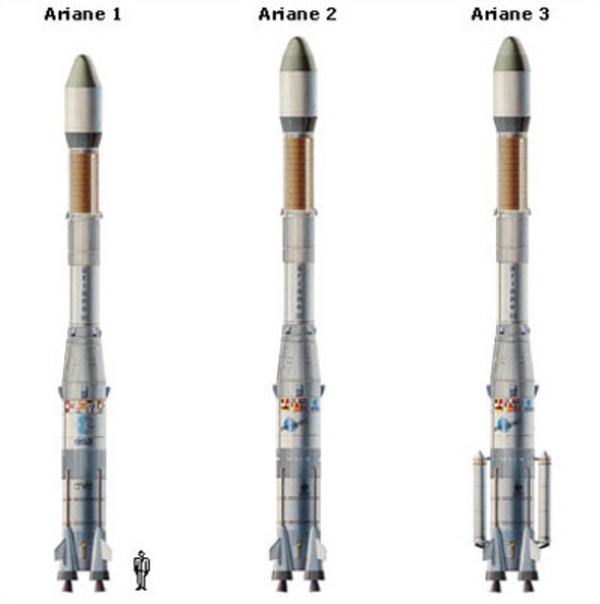 Ariane 1, 2 and 3 launch vehicles. (credit: ESA) |
Consequently, by pulling out when it did, a British Treasury goal that space should “pay its own way” was totally missed out on, perhaps due to the Treasury inability to foresee any economic payback from satellites. For instance, in 1966 they stated that “TV transmission by satellite… is never likely to be economic” [5, p. 340]. This is the sort of mistake that can be made when technical decisions are made by non-technical people.
Blue Streak/Centaur concept, 1972
As the Europa program came to an end, Hawker Siddeley Dynamics (the successor company to de Havilland Propellers) made a last-ditch effort to keep Blue Streak in production by carrying out a study that examined combining it with an American Centaur second stage [5, pp. 199-201]. This made some technical sense, as by this point both Blue Streak and Centaur were reliable, flight-tested vehicles; in particular, Centaur was past its early development problems [12]. In addition, Blue Streak, like Atlas and Centaur, had a 10-foot (3-meter) diameter stainless steel structure and partially shared their pressure-stabilized design [4]. A Blue Streak-Centaur would therefore resemble a somewhat truncated Atlas-Centaur, given the 70-foot (21.3-meter) length of Blue Streak versus the 85-foot (25.9-meter) length of the Atlas. (This reduced size reflects the fact that Blue Streak was an intermediate range missile, while the Atlas was intercontinental.) Since a Centaur would be approaching the maximum upper stage mass feasible with Blue Streak, the study also included the optional addition of a pair of French Nord Aviation L17 liquid propellant boosters (derived from the Diamant launch vehicle). Launch would be from Kourou.
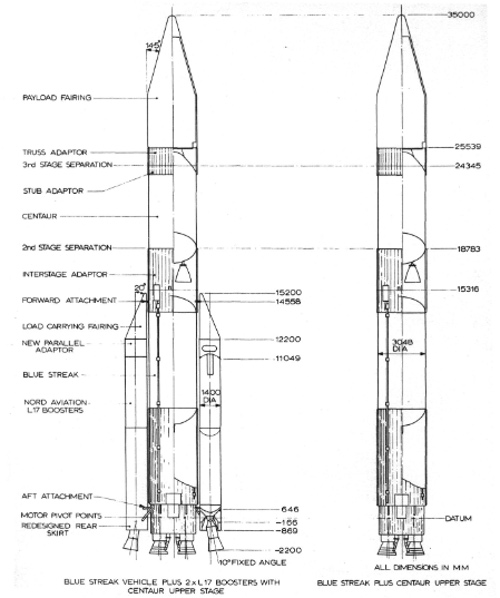 Blue Streak/Centaur concept with strap-on boosters (left) and without (right). (credit: Hill, A Vertical Empire) |
But, while this development made sense technically, from the political point of view it was severely flawed. By the time it was proposed, the British government had no further interest in funding launcher development: such efforts had passed to the French. And they, in turn, had no interest in using an American upper stage, even if it were eventually to be built under license in Europe. The Blue Streak/Centaur launch vehicle therefore went nowhere, and the Blue Streak story came to an end.
Concluding remarks
As a final observation, all through the development of Blue Streak, Black Knight, and Black Arrow, the British Treasury took a penny-pinching approach to their funding. As one small example, when a single Ford Prefect car (not a fleet) was requested in March 1958 for transportation at the isolated Spadeadam rocket engine test site, the response from the Treasury was [5, p. 117]:
We… would be grateful if you would substitute a Ford Popular for the proposed Ford Prefect. Hundreds of Populars are in use in Government service, and we would rather keep to this cheaper 4-seater model.
This focus on saving two or three hundred pounds brings to mind a phrase from the film The Right Stuff: “No bucks, no Buck Rogers”. And so, in the end, it turned out.
References
- Defence: Outline of Future Policy, Command Paper 124, Secretary of State for Defence, Her Majesty’s Stationery Office, London, April 1957.
- “Isle of Wight aerospace: flying boats, rocket interceptors, hovercraft, and launch vehicles”, T. Williams, The Space Review, September 23 (Part 1) and September 30 (Part 2), 2024.
- Blue Streak: Britain’s Medium Range Ballistic Missile, J. Boyes, Fonthill, 2019.
- Bossart: America’s Forgotten Rocket Scientist, D.P. Mitchell, Mitchell Publishing, 2016.
- A Vertical Empire: History of the British Rocketry Programme, C.N. Hill, Imperial College Press, 2012 (2nd edition).
- The Challenge of Space, G.K.C. Pardoe, Chatto and Windus, 1964.
- “Woomera Range Prepares for Blue Streak Launch”, Aviation Week & Space Technology, January 25, 1960, p. 58.
- Observing Earth Satellites, D. King-Hele, Macmillan, 1966.
- “Blue Streak Shutdown Traced to Autopilot”, Aviation Week & Space Technology, July 20, 1964, p. 24.
- “Europa 2 Loss Tied to Guidance System”, Aviation Week & Space Technology, November 22, 1971, p. 19.
- “Britain Plans to end ELDO Participation” and “French Continuing Booster Efforts”, Aviation Week & Space Technology, June 13, 1966, p. 38.
- “The difficult early life of the Centaur upper stage”, T. Williams, The Space Review, March 11, 2024.
Note: we are now moderating comments. There will be a delay in posting comments and no guarantee that all submitted comments will be posted.
